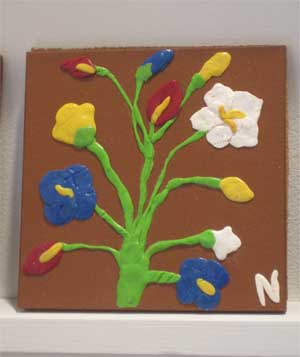
New exhibit at Somerville Museum examines illness and art
By Lauren C. Ostberg
Viesia Novosielsk, 32, is almost too perfect a spokesperson for the Somerville Museum’s “Art on Emotion: Making Connections” exhibit. She’s sculpted a likeness of her ward in Pembroke, where she was admitted as an inpatient at the age of 12. She paints vivid emotion in violent colors, gritty texture. She has been publicly performing “The Dangers of Empathy,” a play she and her mother wrote about their shared experience of Viesia’s illness and recovery, for the past 10 years.
And now, as a working artist and a soon-to-be graduate of the Harvard Extension School, Viesia is also a poet who speaks in made-for-art-opening sound bites. “Art at its purest is a prayer of the heart,” she said. Creating new pieces “was the only way that I could express hope.”
One of Viesia’s favorite pieces in the exhibit portrays Molly, a fellow inpatient, assuming an anguished, feral pose; Viesia’s self-portrait sits across the wall, meeting her intense gaze.
That memory of Molly used to overwhelm her. Now, she says, she’s learned to express empathy safely. She is strong enough to look back.
Viesia’s mother, June Gross, coauthor of “The Dangers of Empathy” and now a mental health professional herself, takes a different angle. “You really lose your privacy, your agency, when something like that [Viesia’s inpatient experience at the age of 12] happens,” she said. You are identified, labeled, and judged, she said, from the outside in. “We wanted to show the emotional impact from the inside out.” Their performance draws on the myth of Demeter and Persephone, at once displaying their mother-daughter intimacies and connecting them to a larger, more universal, relationship.
The exhibit, and the handouts that accompany it, posit that art has many purposes: to soothe, to articulate, to reframe, and, most significantly, to self-identify. Paul Thompson, 57, concert manager and jack-of-all-instruments for the band Tunefoolery, uses the group as way to focus on his identity as a musician, not his disability.
Thompson has been a musician since 1963, a mental health consumer since his early 20s, and a member of Tunefoolery since its inception in 1994. The group began as a four-man band at the Cambridge/Somerville Social Club, a drop-in center for locals with psychiatric disabilities.
“So much of the mental health field focuses on pathology, what’s wrong,” Thompson said. He adds that therapy is not overtly goal-oriented,

Many student groups, including the Girl Scouts and Books of Hope, contributed their work to this exhibit. -Photo by Lauren Ostberg
either – it’s more about maintenance. Vocation, and avocation, on the other hand, come with a purpose. The audition-only group is active – they logged more than 60 performances last year – and compensated for their time. “It gives me a sense of empowerment,” Thompson said. “A light at the end of the tunnel.”
Not all of the exhibits are so cheerful. Some of the most aesthetically pleasing paintings are the works of Erik Coutoumas, 27, who writes that he, “mostly paints to stay sane.” His use of color and texture is lovely, but the starkness of his black and white “No Quarter” also demands attention. The exhibit aims to provide an honest emotional outlet, and hits its mark here, with a straightforward artistic statement describing an increasingly pedestrian experience. “Inspired by being laid off the day before Thanksgiving,” he wrote. “I just wanted to paint something I could crawl into and die.”
















Reader Comments